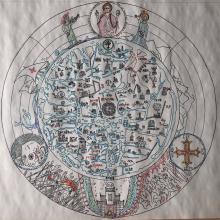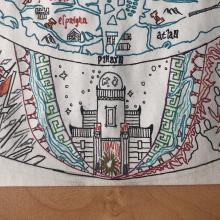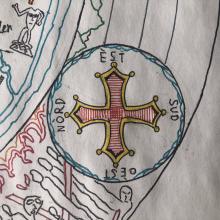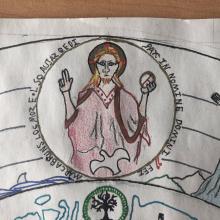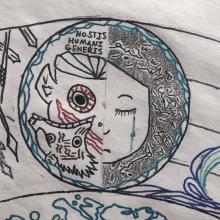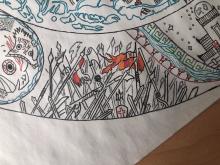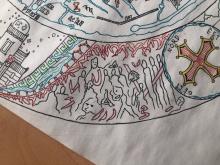Borderless is a mapamundi (medieval-styled world map) that represents Marcabru’s Pax in Nomine Domini while putting different types of “Occitanian crusades” into conversation. The project is rooted in the idea that sound – language and music – can embody a type of conquest or reclamation. For Marcabru in the 12th century, this manifested itself in the propagandic use of vernacular poetry to incentivize warriors and noblemen to cleanse their sins at a distant “washing place.” For modern Occitanian activists, a crusade is waged against a suffocating French nation-state by promoting the use of Occitan, speaking the language of the land. For refugees, many of whom are Muslim and North African, sustaining mother tongues may be a reclamation of livelihood and identity. In each scenario, goals that are intangible in the moment (the holy land, Occitanian independence, and an end to xenophobia) are turned tangible by the flick of a tongue, the movement of the mouth, the significance of sound.
Similarly, the map makes tangible the various “holy lands” and utopias of the three crusades. A constellation of symbols can take on a material, physical form just as language is inherently physical. The center of the map is inspired by the Hereford Mapamundi (c. 1300), which centers Jerusalem and provides a whole timeline of Christian thought from the birth of Christ to his resurrection. The map’s toponyms were inspired both by the places mentioned in Pax in Nomine Domini and by our trips to various keeps and cities over the seminar. In the end, the piece offers a space for the confluence of three different struggles that, at one point or another, have gripped the “Other France.”
Bibliography
Barton, Simon. The Aristocracy in Twelfth-Century León and Castile. Cambridge University Press, 1997.
Annotation: This secondary source provided information on the political and cultural environment that Marcabru was situated in, which was used to better understand Pax in Nomine Domini as poetic propaganda.
Gaunt, Simon, Ruth Harvey, and Linda Paterson. Marcabru: A Critical Edition. D.S. Brewer, 2000.
Annotation: This source was used for clarification of Marcabru’s poetry in terms of place names.
Goldin, Frederick. Lyrics of the Troubadours and Trouvéres. Peter Smith, 1983.
Annotation: Goldin’s anthology specified the origins of Marcabru, his style of Trobar Clus, and the lords that he may have been appealing to in his crusader poetry. This last piece of information was then used to determine the coloring arrangements of the mass of weapons at lower-left.
Note: Other major sources of inspiration for this project, in addition to Marcabru’s poem, include the Hereford Mapamundi, Matfré Ermengau’s Chansonnier Occitan (c. 1301-1400), “The Road to Damascus” (a Performing Trobar project from a former student), a discussion with two Occitanian activists (8/17/2019), and a group visit to Toulouse’s Jacobins basilica.

